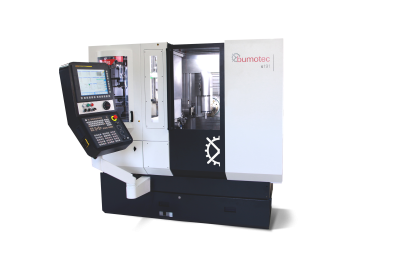
Starrag has demonstrated over the years that the nonexhaustive list of applications performed on its model Bumotec s191FTLR 7-axis turn/mill machine is an evidence of Starrag’s expertise in manufacturing complex parts in a single setup whatever raw materials used. Whether for producing parts in the micro-mechanics, aerospace, medtech or luxury goods sectors, Bumotec machining centers dedicated to small workpieces turn out to be a major asset to achieve your production goals and overcome the current market challenges. In the medical field, requiring high level of precision and repeatability, the company's technology is often used to obtain the cost-effective solution for producing implants combining grinding, milling, turning, drilling and polishing processes without interruption.
The requirement to manufacture complex micro size parts is in high demand - particularly hard materials used in medtech industry. One such example is the “femoral head” made out of chrome cobalt. The company's approach to this manufacturing challenge is to start with a plain bar and finish the femoral head in one single setup. The Bumotec s191FTLR machine model (turning, milling, linear motor, retaking) is able to perform six-sided machining, including the grinding of the spheric shape (sphericity 2.5 μm) with such precision and the accurate polishing operation (roughness RA 0.05) without interruption of the cycle, which takes about 12 minutes to complete. Once the bar are loaded, the machine takes very little supervision.
The requirement to produce a precise femoral head is accomplished by using the machine’s dynamic correction capabilities and Renishaw’s contactless part probing techniques. With its uniquely designed full-size subspindle, the FANUC linear motor driven Bumotec s-191FTLR is able to precisely turn, mill, grind, surface finish and f5-axis machine medical femoral head from high mix small batches to large-volume serial production.
The advantage of machining such complex shapes in a single cycle is realized through: quick change over, higher productivity, lower cycle times, less floor space and the sharp reduction in part handling. These benefits yield a more accurate and reproducible part at a lower manufacturing cost than traditional machining methods requiring numerous setups over various machines.
Contact Details
Related Glossary Terms
- centers
centers
Cone-shaped pins that support a workpiece by one or two ends during machining. The centers fit into holes drilled in the workpiece ends. Centers that turn with the workpiece are called “live” centers; those that do not are called “dead” centers.
- gang cutting ( milling)
gang cutting ( milling)
Machining with several cutters mounted on a single arbor, generally for simultaneous cutting.
- grinding
grinding
Machining operation in which material is removed from the workpiece by a powered abrasive wheel, stone, belt, paste, sheet, compound, slurry, etc. Takes various forms: surface grinding (creates flat and/or squared surfaces); cylindrical grinding (for external cylindrical and tapered shapes, fillets, undercuts, etc.); centerless grinding; chamfering; thread and form grinding; tool and cutter grinding; offhand grinding; lapping and polishing (grinding with extremely fine grits to create ultrasmooth surfaces); honing; and disc grinding.
- linear motor
linear motor
Functionally the same as a rotary motor in a machine tool, a linear motor can be thought of as a standard permanent-magnet, rotary-style motor slit axially to the center and then peeled back and laid flat. The major advantage of using a linear motor to drive the axis motion is that it eliminates the inefficiency and mechanical variance caused by the ballscrew assembly system used in most CNC machines.
- milling
milling
Machining operation in which metal or other material is removed by applying power to a rotating cutter. In vertical milling, the cutting tool is mounted vertically on the spindle. In horizontal milling, the cutting tool is mounted horizontally, either directly on the spindle or on an arbor. Horizontal milling is further broken down into conventional milling, where the cutter rotates opposite the direction of feed, or “up” into the workpiece; and climb milling, where the cutter rotates in the direction of feed, or “down” into the workpiece. Milling operations include plane or surface milling, endmilling, facemilling, angle milling, form milling and profiling.
- milling machine ( mill)
milling machine ( mill)
Runs endmills and arbor-mounted milling cutters. Features include a head with a spindle that drives the cutters; a column, knee and table that provide motion in the three Cartesian axes; and a base that supports the components and houses the cutting-fluid pump and reservoir. The work is mounted on the table and fed into the rotating cutter or endmill to accomplish the milling steps; vertical milling machines also feed endmills into the work by means of a spindle-mounted quill. Models range from small manual machines to big bed-type and duplex mills. All take one of three basic forms: vertical, horizontal or convertible horizontal/vertical. Vertical machines may be knee-type (the table is mounted on a knee that can be elevated) or bed-type (the table is securely supported and only moves horizontally). In general, horizontal machines are bigger and more powerful, while vertical machines are lighter but more versatile and easier to set up and operate.
- polishing
polishing
Abrasive process that improves surface finish and blends contours. Abrasive particles attached to a flexible backing abrade the workpiece.
- turning
turning
Workpiece is held in a chuck, mounted on a face plate or secured between centers and rotated while a cutting tool, normally a single-point tool, is fed into it along its periphery or across its end or face. Takes the form of straight turning (cutting along the periphery of the workpiece); taper turning (creating a taper); step turning (turning different-size diameters on the same work); chamfering (beveling an edge or shoulder); facing (cutting on an end); turning threads (usually external but can be internal); roughing (high-volume metal removal); and finishing (final light cuts). Performed on lathes, turning centers, chucking machines, automatic screw machines and similar machines.

